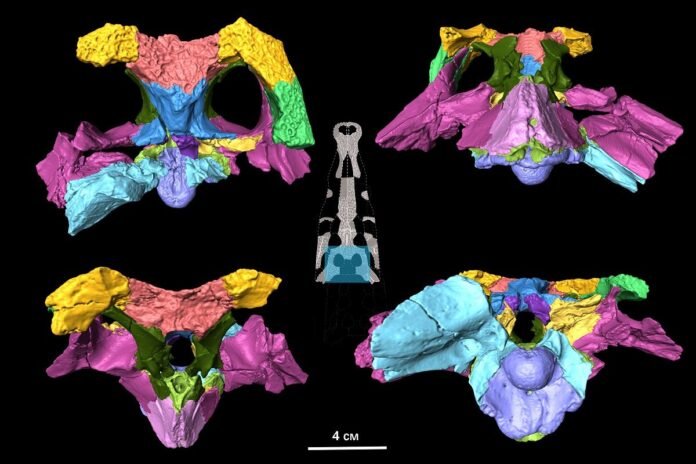A joint team of scientists from St. Petersburg State University, the Zoological Institute of the Russian Academy of Sciences, the Research Institute of Artificial Intelligence and Sechenov University, using CT scanning, reconstructed the brain of an ancient relative of modern crocodiles.
SPbSU
To facilitate perception, individual bones in the illustrations presented by scientists are highlighted in different colors.
According to the St. Petersburg State University, the work was carried out with a grant from the Russian Science Foundation. The scientists studied fragments of the skull of the crocodylomorph Kansajsuchus, a representative of the species Kansajsuchus extensus.
These creatures belonged to the extinct family of paraligatoridae and were the largest among them. According to scientists, they reached a length of 4 to 5 meters, and the largest individuals could grow up to 7 meters.
The Kansaizhus lived about 85 million years ago and their fossilized remains were found in the 1960s in the territory of present-day Tajikistan during several expeditions led by Moscow paleontologist Anatoly Rozhdestvensky.
They are named after the village of Kansai in Tajikistan, near which the fossils were discovered. The latter are now kept in the collection of the Paleontological Museum named after Yu.A. Orlova in Moscow.
As part of the new study, scientists were able to use CT scanning to reconstruct Kansaizu’s brain and nervous system using fragments of the skull. A 3D reconstruction of the skull was created from the CT scan data.
To facilitate perception, individual bones in the illustrations presented by scientists are highlighted in different colors. Paleontologists also managed to make casts of the internal cavities of the skull, where the brain, nerves, blood vessels, inner ear and pneumatic sinuses are located. The results of the study suggest that ancient creatures and modern crocodiles had similar cognitive abilities.
“We described the bones of Kansaizuha in some detail in 2019, but the internal structure of its skull was unknown,” says Ivan Kuzmin, associate professor at the Department of Vertebrate Zoology at St. Petersburg State University.
– In our new study, using CT scanning and 3D modelling, we studied three fragments of the skull, including almost the entire braincase. This made it possible to create three-dimensional models of cranial bones that would otherwise be impossible to study in detail.”
This species was first described in 1975 and for many years was mistakenly attributed to another family of crocodylomorphs – Goniopholididae. But in 2019, scientists from St. Petersburg State University re-identified the fossils and assigned these creatures to the Paralligatoridae family.
“This is a completely extinct group of crocodylomorphs, close to the common ancestor of all modern crocodiles,” St. Petersburg State University reported. “They existed in Asia during the Cretaceous period (approximately 130-66 million years ago), in appearance and lifestyle were similar to their modern relatives: they led a semi-aquatic lifestyle and were predators.”

